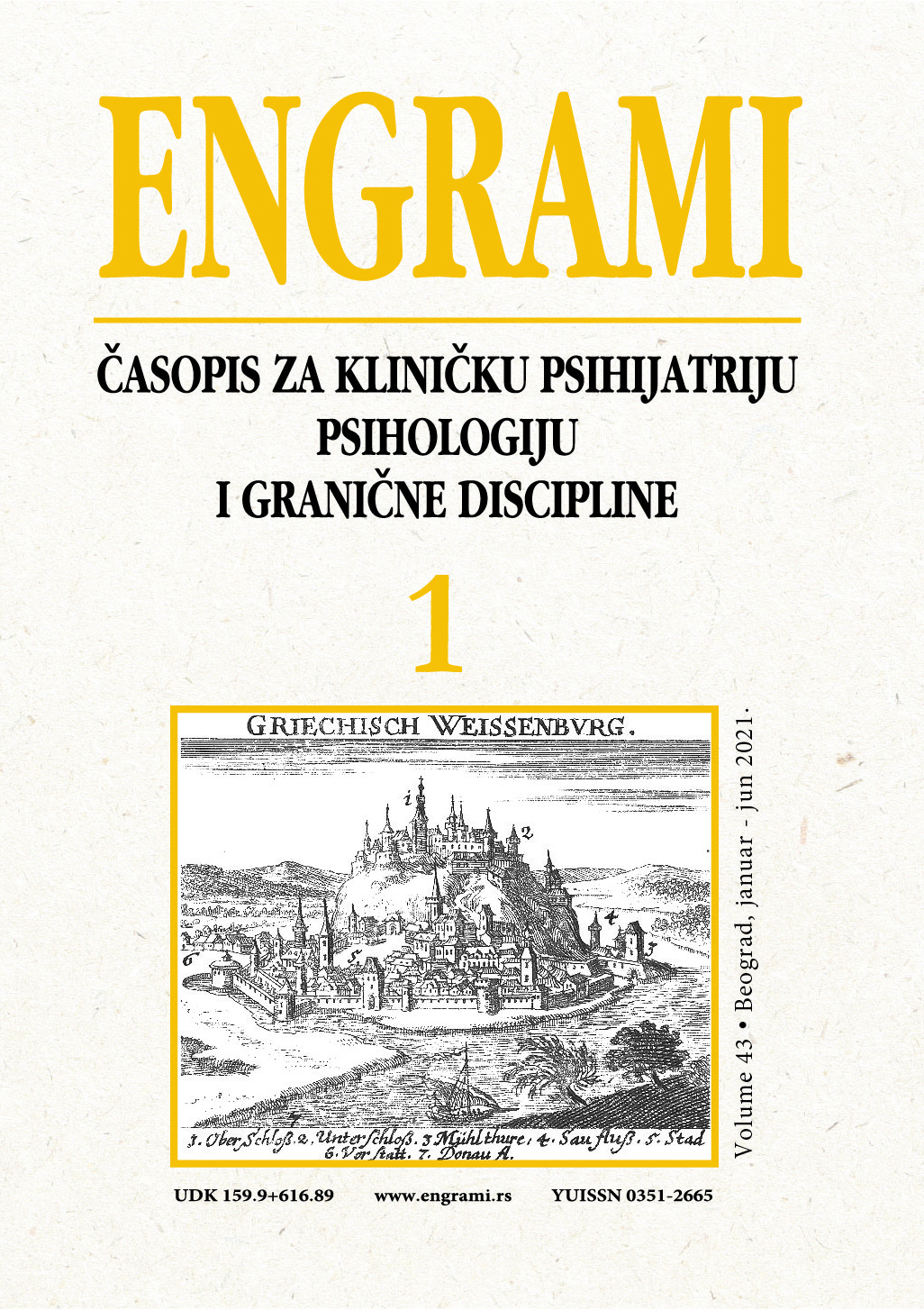Phenomenology, psychopathology and phenomenological psychopathology
Abstract
The observation, description and definition of the structure of psychopathological phenomena make up the foundation of clinical psychiatry. Phenomenology can be defined as a group of philosophical principles that are dedicated to the systematic analysis of consciousness and its objects. Phenomenological psychopathology is the application of phenomenological principles to psychopathology. The goal of phenomenological psychopathology is to make explicit the subtle structures of pathological experience. Thus, the use of the phenomenological method enables us to disclose the indistinct or neglected psychopathological phenomena. It allows us to systematically construct a psychopathological taxonomy. This paper defines and summarizes the following topics: (1) phenomenology as a set of philosophical doctrines; (2) phenomenological psychopathology and its application in clinical work; (3) the significance of Karl Jaspers for phenomenological psychopathology and psychiatry; (4) contemporary trajectories of phenomenological psychopathology. A comprehensive understanding of the concept of phenomenological psychopathology is a prerequisite for the prices understanding of the subjective experience of a psychiatric patient.
References
2. Berrios GE. What is phenomenology? A review. J R Soc Med. 1989;82(7):425–8.
3. Stepanovic S. Filozofske pretpostavke Jaspersove Opšte psihopatologije. Filozofski Fakultet, Univerzitet u Beogradu; 2005.
4. Berrios GE. Phenomenology, psychopathology and Jaspers: a conceptual history. Hist Psychiatry. 1992;3(11):303–27.
5. Sartre J-P. Intentionality: a fundamental idea of Husserl’s phenomenology. J Br Soc Phenomenol. 1970;1(2):4–5.
6. Jaspers K. Opšta psihopatologija. Beglrade: Prosveta, Savremena administracija; 1978. 14 p.
7. Miresco MJ, Kirmayer LJ. The persistence of mind-brain dualism in psychiatric reasoning about clinical scenarios. Am J Psychiatry. 2006;163(5):913–8.
8. Merlo-Ponti M. Fenomenologija percepcije. Sarajevo: Veselin Masleša; 1978.
9. Tillman MK. Dilthey and Husserl. J Br Soc Phenomenol. 1976;7(2):123–30.
10. Morrison JC. Husserl and Brentano on intentionality. Philos Phenomenol Res. 1970;31(1):27–46.
11. Huserl E. Ideja fenomenologije. Beograd: Bigz; 1975.
12. Huserl E. Logička istraživanja. Zagreb: Breza; 2005.
13. Huserl E. Kriza evropskih nauka. Gornji Milanovic: Decije novine; 1991.
14. Stanghellini G, Broome M, Fernandez AV, Raballo A. The Oxford handbook of phenomenological psychopathology. Oxford University Press, USA; 2019.
15. Fuchs T. Phenomenology and psychopathology. In: Handbook of phenomenology and cognitive science. Springer; 2010. p. 546–73.
16. Sass L, Parnas J, Zahavi D. Phenomenological psychopathology and schizophrenia: contemporary approaches and misunderstandings. Philos Psychiatry, Psychol. 2011;18(1):1–23.
17. Parnas J, Sass L, Zahavi D. Phenomenology and psychopathology. Philos Psychiatry, Psychol. 2011;18(1):37–9.
18. Jerotic S. Prejudices in the psychopathologist: Karl Jaspers’ heritage. Eur Arch Psychiatry Clin Neurosci. 2021;1–8.
19. Beumont PJ V. Phenomenology and the history of psychiatry. Aust N Z J Psychiatry. 1992;26(4):532–45.
20. Telles-Correia D, Saraiva S, Marques JG. Jaspers’ Phenomenology. Folia Med (Plovdiv). 2018;60(3):373–80.
21. Janzarik W, Viviani R, Berrios GE. Jaspers, Kurt Schneider and the Heidelberg school of psychiatry. Hist Psychiatry. 1998;9(34):241–52.
22. Ey H. Esquirol et le problem des hallucinations. Evol Psychiatr. 1939;1:21–44.
23. Telles-Correia D, Moreira AL, Goncalves JS. Hallucinations and related concepts—their conceptual background. Front Psychol. 2015;6:991.
24. Doerr-Zegers O, Pelegrina-Cetrán H. Karl Jaspers’ General Psychopatholgy in the framework of clinical practice. In: Stanghellini G, Fuchs T, editors. One century of Karl Jaspers’ general psychopathology. 2013. p. 57–75.
25. Jaspers K. The phenomenological approach in psychopathology. Br J Psychiatry. 1968;114(516):1313–23.
26. Bormuth M. Karl Jaspers. In: Stanghellini G, Broome M, Fernandez AV, Fusar-Poli P, Raballo A, Rosfort R, editors. The Oxford Handbook of Phenomenological Psychopathology. Oxford University Press; 2019.
27. Broome M. Jaspers and neuroscinece. In: Stanghellini G, Fuchs T, editors. One century of Karl Jaspers’ general psychopathology. 2013. p. 121–32.
28. Häfner H. Descriptive psychopathology, phenomenology, and the legacy of Karl Jaspers. Dialogues Clin Neurosci. 2015 Mar;17(1):19–29.
29. Ghaemi SN. The concepts of psychiatry: a pluralistic approach to the mind and mental illness. JHU Press; 2003.
30. Varela FJ. Neurophenomenology: A methodological remedy for the hard problem. J Conscious Stud. 1996;3(4):330–49.
31. Parnas J, Møller P, Kircher T, Thalbitzer J, Jansson L, Handest P, et al. EASE: examination of anomalous self-experience. Psychopathology. 2005;38(5):236.
32. Sass L, Pienkos E, Skodlar B, Stanghellini G, Fuchs T, Parnas J, et al. EAWE: Examination of Anomalous World Experience. Psychopathology. 2017;
33. Ratcliffe M. The phenomenology of depression and the nature of empathy. Med Heal Care Philos. 2014;17(2):269–80.
34. Madeira L, Carmenates S, Costa C, Linhares L, Stanghellini G, Figueira ML, et al. Basic self-disturbances beyond schizophrenia: discrepancies and affinities in panic disorder-an empirical clinical study. Psychopathology. 2017;50(2):157–68.
35. Parnas J, Henriksen MG. Mysticism and schizophrenia: A phenomenological exploration of the structure of consciousness in the schizophrenia spectrum disorders. Conscious Cogn. 2016;43:75–88.
36. Williams S, Reid M. ‘It’s like there are two people in my head’: A phenomenological exploration of anorexia nervosa and its relationship to the self. Psychol Health. 2012;27(7):798–815.
37. Burkitt I, Sanz J. Embodiment, lived experience and anorexia: the contribution of phenomenology to a critical therapeutic approach. Athenea Digit Rev Pensam e Investig Soc. 2001;38–52.
38. Broome MR, Owen GS, Stringaris A. The Maudsley reader in phenomenological psychiatry. Cambridge University Press; 2012.

